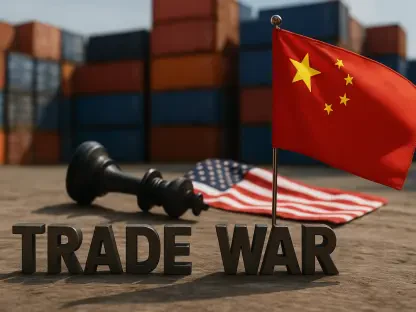The financial world is witnessing a profound transformation as retail investors increasingly turn away from the complexities of options trading and dive into the dynamic realm of futures trading, signaling a pivotal shift in the derivatives landscape that is reshaping the market. Once considered the exclusive playground of institutional giants, futures markets are now drawing in everyday traders eager to capitalize on new opportunities with fewer barriers. Frustrations with options—ranging from intricate risk metrics like delta and theta to stringent regulations such as the Pattern Day Trader rule requiring substantial account balances—have pushed many to explore futures as a more accessible alternative. This growing trend is not merely a local phenomenon but a global movement, reshaping how individuals engage with sophisticated financial instruments. With trading volumes climbing by 15-30% year-over-year across regions like EMEA and APAC, the impact of this shift is undeniable, setting the stage for a deeper examination of its implications.
Transforming Market Structures
Surging Liquidity and Market Efficiency
The wave of retail participation in futures trading has injected unprecedented liquidity into derivatives markets, fundamentally enhancing their efficiency. Data from CME’s Micro products reveals an average daily volume of 4.1 million contracts in the second quarter of this year, with significant contributions from instruments like the Nasdaq 100 Micro E-mini. This surge in trading activity translates to tighter bid-ask spreads, minimizing slippage and fostering more accurate price discovery. Such conditions create a more favorable environment for all market participants, from small-scale retail traders to large institutional investors. The democratization of access through micro and mini contracts, which lower the capital needed to enter high-value markets, has been a key driver of this liquidity boom, enabling broader engagement with major indices and commodities that were once out of reach for many.
Beyond the immediate benefits of liquidity, this trend is also reshaping the operational dynamics of futures markets on a global scale. The increased volume of trades facilitates smoother transactions and reduces the cost of executing orders, a critical advantage in fast-paced financial environments. Moreover, the presence of more participants helps stabilize pricing mechanisms, as diverse trading strategies and perspectives contribute to a more balanced market. This liquidity surge, particularly evident in regions outside the U.S., such as EMEA and APAC, underscores a structural shift that is not just enhancing market depth but also attracting sophisticated players like algorithmic trading firms. These entities thrive on the improved conditions, further amplifying the efficiency gains that retail traders have helped initiate through their growing involvement.
Navigating Heightened Volatility
While the influx of retail traders boosts liquidity, it also introduces significant volatility into futures markets, presenting both opportunities and challenges. Unlike options, which offer defined risk through premiums, futures trading carries the potential for unlimited losses due to leverage, making price swings a critical concern. Markets such as natural gas and Bitcoin futures often experience daily fluctuations of 10-15%, driven by external factors like geopolitical tensions or sudden shifts in investor sentiment. This level of volatility can be a double-edged sword, offering the potential for substantial gains but also posing severe risks, especially to less experienced retail traders who may lack the tools or knowledge to manage rapid market changes effectively.
The heightened volatility in futures markets has also drawn attention from high-frequency trading firms, which capitalize on quick price movements and tighter spreads. These firms leverage advanced algorithms to execute trades at lightning speed, often exacerbating short-term price swings and adding another layer of complexity for retail participants. For individual traders, the challenge lies in developing strategies to mitigate these risks, whether through stop-loss orders or diversifying across different asset classes. The inherent unpredictability of certain futures markets, influenced by seasonal patterns or macroeconomic events, necessitates a cautious approach, as sudden shifts can wipe out gains in a matter of hours. This dynamic underscores the need for education and risk management as retail traders navigate this volatile landscape.
Adapting Investment Strategies
Redefining Portfolio Construction
As retail investors increasingly integrate futures into their financial toolkit, traditional approaches to portfolio management are undergoing a significant overhaul. Futures on prominent instruments like the S&P 500, gold, and Eurodollar are no longer viewed solely as speculative vehicles but as essential components for hedging against market uncertainties and diversifying risk. This strategic pivot reflects a broader recognition among retail traders of the need to align their investments with macroeconomic trends, such as interest rate shifts or commodity price movements. By incorporating futures, individuals can better position themselves to weather volatility while seeking returns, marking a departure from reliance on more conventional options-based strategies.
This evolution in investment thinking also highlights the adaptability required in today’s fast-changing financial environment. Retail traders are learning to use futures to balance exposure across different sectors, whether by hedging equity positions with index futures or using commodity futures to offset inflation risks. The accessibility of micro contracts plays a crucial role here, allowing smaller investors to experiment with these strategies without committing large sums of capital. As a result, portfolios are becoming more resilient and tailored to individual risk tolerances, reflecting a sophisticated understanding of market forces. This shift not only empowers retail traders but also contributes to a more diverse and dynamic market, where varied approaches help stabilize overall activity even amid turbulent conditions.
Spotlight on Industry Innovators
The retail futures trading boom has created fertile ground for certain financial entities to thrive, positioning them as key beneficiaries of this market transformation. CME Group leads the charge with its innovative micro contracts, which have lowered entry barriers and fueled global participation through scalable platforms. Similarly, platforms like Robinhood are tapping into a younger demographic by offering commission-free futures trading via specialized tools like their “Legend” platform, making the market more approachable for new entrants. These developments signal a broader industry trend toward inclusivity, where accessibility drives growth and engagement across diverse investor groups.
In addition to exchanges and trading platforms, exchange-traded funds (ETFs) tied to futures strategies are gaining traction as accessible investment vehicles for retail traders. Products like SPDR Gold Trust and iMGP DBi Managed Futures Strategy ETF provide exposure to commodities and managed futures without the need for direct trading, catering to those seeking simpler entry points. Meanwhile, fintech companies such as Interactive Brokers are enhancing their offerings to meet the rising demand for futures trading tools, ensuring that retail investors have the resources needed to compete. These industry players, through innovation and adaptation, are not only capitalizing on the retail surge but also shaping the future of derivatives markets by prioritizing ease of access and strategic diversity.
Looking Ahead: Navigating New Horizons
Reflecting on the rapid rise of retail futures trading, it becomes evident that this movement has fundamentally altered the derivatives landscape by broadening participation and reshaping market dynamics. The surge in liquidity and the accompanying volatility have challenged traders to adapt swiftly, while strategic shifts in portfolio construction mark a new era of investor sophistication. Industry innovators have seized the moment, delivering tools and products that empower retail traders to engage with confidence. Moving forward, the focus should center on enhancing education and risk management resources to equip individuals for the complexities of futures markets. Exploring diversified investment vehicles, such as ETFs linked to futures, could offer safer pathways for participation. Additionally, keeping a close eye on global trends and regulatory developments will be crucial for anticipating future shifts. By embracing these steps, retail investors can harness the opportunities of this evolving market while mitigating its inherent risks, paving the way for sustained growth and stability.









